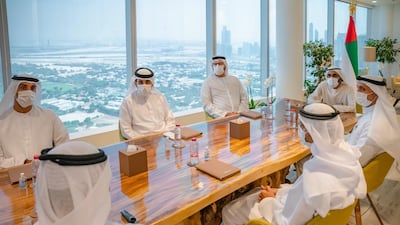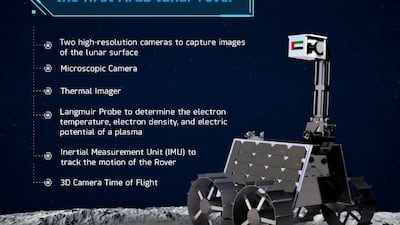The UAE intends to land its Rashid rover on the near side of the moon, selecting five possible locations before the landmark mission.
Officials are laying the groundwork for a planned 2024 launch, in the latest significant step forward for the country's burgeoning space sector.
The UAE's Hope Probe - the first Arab mission to Mars - is set to reach the Red Planet in February.
Now, the country has it sights firmly set on travelling to the Moon.
The mission was announced by Sheikh Mohammed bin Rashid, Vice President and Ruler of Dubai, last month.
Compared to the far side of the Moon, the near side offers a smoother surface with less craters.
The majority of lunar missions so far have explored only the Earth-facing side of the Moon, with notable exceptions including China's Chang'e-4 probe that became the first to land on the far side in 2019, the Soviet Luna 3 orbiter that captured the first images in 1959, the Apollo 8 mission in 1968 and Apollo 16.
Hamad Al Marzooqi, head of the Emirates Lunar Mission, said they are selecting areas on the Moon that remain unexplored and match a certain criteria.
"It (the location) has to have interesting features that can be explored through our science instruments," he said, during a virtual forum held by the Italian Embassy in the UAE on Thursday.
"The area should have no slopes bigger than 15 degrees, the distribution of boulders should be less than 30 centimetres in height; it will be near side of the moon and we are targeting mid-latitude locations."
A primary location and a back-up location will be selected soon.
Near side versus far side
The far side of the Moon has a rougher surface, with more craters and less maria – the large, dark, plains on the moon believed to be formed by ancient volcanic eruptions.
The near side experienced more volcanic eruptions, helping create a smoother surface.
Only the near side is visible from Earth because the Moon rotates on its axis at the same rate it orbits the Earth.
Some of the far side is visible, however, because the Moon’s elliptical orbit shows areas beyond its east and western horizons. The Moon seasons tend to show very little of the North and South poles.
Scientific research on Moon
Mr Al Mazrooqi said the mission's key scientific areas of interest are studying the properties of lunar regolith – lunar soil.
The mission will study the petrography and geology of the Moon.
Another focus area will be studying the lunar surface plasma conditions, photoelectron sheath and dust transportation.
The mission will also help determine what kind of future mission technologies are needed.
Its findings will contribute to global efforts to build a space station, called Lunar Gateway, in the Moon's orbit.
The UAE could benefit from that space station, as it works towards its long-term goal of building a city on Mars by 2117.
The US' 'Moon to Mars' programme has brought forward many international supporters.
Rover specifics
Rashid will be able to travel at a maximum speed of 10 centimetres per second.
The rover, equipped with four wheels, can climb over an obstacle at a maximum height of 10 centimetres and descend down on slope of 20 degrees.
It will have two high resolution optical imagers for photos – the CAM-1 and Cam-2.
The thermal imager, CAM-T, is the scientific camera, which can analyse different properties on the moon using the particle's thermal energy.
The Langmuir Probes on the rover will analyse the lunar surface charge and electric fields.
Emirati engineers will build the rover, but the lander – a landing spacecraft that holds the rover – is to be acquired through either an international partner or commercial provider.
"We are currently negotiating with different potential partners and we are at an advanced stage in (selecting) a lander, and we'll disclose the conclusions of these discussions in the coming months," said Mr Al Mazrooqi.















